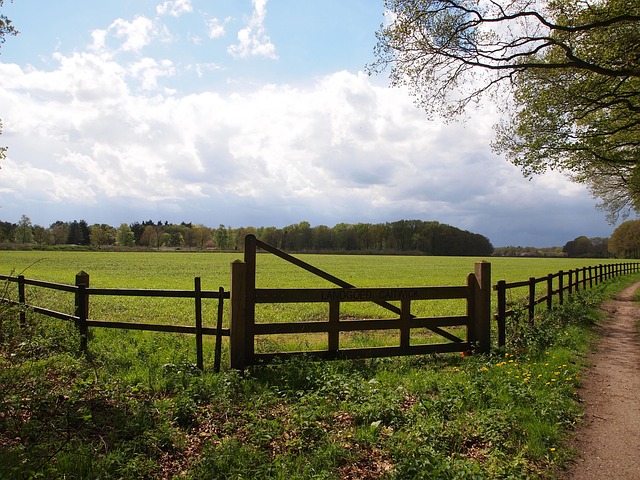Fences are not just structural elements; they can significantly enhance your outdoor space’s aesthetic appeal. This article guides you through the process of fence staining and sealing, ensuring your wooden fences not only look their best but also withstand the elements. From understanding the benefits and types of stain to choosing colors, preparing your fence, applying sealers, and maintaining longevity, we cover everything you need to know for a job well done.
- Understanding Fence Staining: Benefits and Types
- Preparing Your Wooden Fence for Staining
- Choosing the Right Stain: Color Options & Application
- Sealing for Protection: Importance and Best Practices
- Maintenance Tips for Long-Lasting Fence Appearance
Understanding Fence Staining: Benefits and Types
Fence staining is an essential maintenance practice that offers numerous advantages for wooden fences. It involves applying a protective finish to the wood, enhancing its appearance and longevity. The primary benefits include preventing weather damage, blocking UV rays that cause fading, and providing a decorative touch to your outdoor space. By sealing in the natural beauty of the wood, staining ensures it remains vibrant and well-protected against elements like rain, snow, and intense sunlight.
There are various types of fence stains available, each with unique properties. Water-based stains are popular for their low odor and easy application, while oil-based options provide deeper coloration and longer durability. Some advanced formulas even include UV protection, ensuring the stain stays vibrant over time. These different types cater to specific needs, climate conditions, and personal aesthetic preferences, allowing homeowners to choose a solution that best suits their wooden fence.
Preparing Your Wooden Fence for Staining
Before applying any stain or sealer, preparing your wooden fence is a crucial step. Start by thoroughly cleaning the fence to remove any dirt, dust, mildew, or mold. Use a pressure washer or a stiff brush and mild detergent for this process. Ensure the wood is dry before proceeding.
Inspect the fence for any damaged or rotten sections. Repair or replace these parts as needed to maintain the integrity of your fence. Fill any gaps with suitable filler and allow it to dry completely. Sanding the fence lightly can also help to create a smoother surface, allowing the stain to adhere better and provide an even finish.
Choosing the Right Stain: Color Options & Application
Choosing the right stain for your wooden fence is a crucial step in enhancing its aesthetic appeal and protecting it from the elements. First, consider the color options available, ranging from natural wood tones to vibrant hues. Different stains offer various levels of transparency, allowing you to customize the depth of color while still showcasing the wood grain. For a subtle look, opt for semi-transparent or transparent stains that let the wood’s natural beauty shine through. If you prefer a more dramatic effect, solid color stains provide full coverage and can transform your fence into a striking focal point.
When applying the stain, ensure proper preparation of the wooden surface. Start by cleaning the fence to remove any dirt, debris, or existing finish. Fill in any cracks or holes with wood putty and sand the fence smoothly before applying the stain. Choose an appropriate application method, such as brushes, rollers, or sprayers, depending on the size and design of your fence. Always follow the manufacturer’s instructions for drying times between coats to achieve a professional, long-lasting finish.
Sealing for Protection: Importance and Best Practices
Sealing a wooden fence is an essential step to protect it from environmental elements, ensuring its longevity and maintaining its aesthetic appeal. Wood is naturally susceptible to water damage, UV radiation from the sun, and various weather conditions that can cause fading, cracking, and deterioration. Applying a high-quality sealer creates a protective barrier, shielding the fence from these detrimental factors.
The best practices for sealing involve preparing the wood surface properly before application, ensuring even coverage with a brush or roller, and following manufacturer instructions for drying times. Regular maintenance is key; reapply the sealer every one to two years, depending on exposure to sun and weather conditions. This simple step can extend the life of your fence, save you money in the long run by preventing costly repairs, and maintain its beauty as a centerpiece of your outdoor space.
Maintenance Tips for Long-Lasting Fence Appearance
Regular maintenance is key to keeping your wooden fence looking its best and ensuring a long-lasting, vibrant finish. Here are some simple tips to maintain the health and appearance of your fence:
Begin by regularly cleaning your fence to remove any dirt, debris, or mildew buildup. Use a soft brush or garden hose to gently wash the surface. After cleaning, check for any damaged or loose boards and repair them promptly. Regular inspection will help prevent minor issues from becoming major problems. Lastly, re-stain and seal your fence at least once a year, ideally after the winter season, to protect it from the elements and extend its life.
